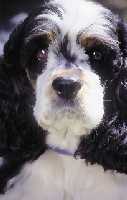| |
Update in prevalence of primary glaucomas in pure-bred dogs
 |
 Picture: © Bayer Animal Health Picture: © Bayer Animal Health
|
 |
How is the prevalence of glaucomas in pure-bred dogs, which breeds are affected, is there any change in the last 40 years and so on: This large, retrospective study gives lots of interesting informations about primary glaucoma (glaucoma-NOS) from 1964 to 2002.
|
 |
 |
|  |
The prevalence of the primary breed-related glaucomas has gradually increased from 0.29% (1964-1973); 0.46% (1974-1983); 0.76% (1984-1993); to 0.89% (1994-2002).
Breeds that consistently featured among the highest 10 for glaucoma prevalence from four different periods (1964 to 2002) included American Cocker Spaniel, Basset Hound, Wire Fox Terrier, and Boston Terrier.
During the last observation period (1994-2002), 22 different breeds had 1% or higher prevalence of the glaucomas. The highest prevalence of glaucomas in 1994-2002 by breed included: American Cocker Spaniel (5.52%); Basset Hound (5.44%); Chow Chow (4.70%); Shar-Pei (4.40%); Boston Terrier (2.88%); Wire Fox Terrier (2.28%); Norwegian ElkHound (1.98%); Siberian Husky (1.88%); Cairn Terrier (1.82%); and Miniature Poodle (1.68%).
A predominance of females with glaucoma occurred in the American Cocker Spaniel, Basset Hound, Cairn Terrier, Chow Chow, English Cocker Spaniel, Samoyed, and perhaps the Siberian Husky, and a predominance of males in the Australian Cattle dog and St Bernard.
Age affected the time for first presentation of the glaucomas in the pure-bred dog. In the majority of breeds the glaucomas were presented for initial diagnosis in dogs between 4 and 10 years of age.
Breed-related glaucomas in pure-bred dogs are frequently presented to the veterinary medical teaching hospitals in North America. The prevalence of the breed-related glaucomas in the dog appears similar to humans, and in some breeds exceeds that in humans. In many breeds the high prevalence of the glaucomas suggests a genetic basis.
Source: Gelatt, Kirk N. & MacKay, Edward O. (2004): Prevalence of the breed-related glaucomas in pure-bred dogs in North America. In: Veterinary Ophthalmology 7 (2), 97-111.
Tell a friend
|
Print version
|
Send this article
|
|  |

Metastasis of a well differentiated perianal gland tumorPunica granatum associated with hepatotoxicosis in cattle Toceranib phosphate (Palladia®) in canine gastrointestinal stromal tumors Toceranib phosphate (Palladia®) in canine gastrointestinal stromal tumors Radioactive iodine uptake in hyperthyroid cats after rh-TSH Radioactive iodine uptake in hyperthyroid cats after rh-TSH Hypoechoic tissue changes in dogs with malignant prostatic lymphoma Hypoechoic tissue changes in dogs with malignant prostatic lymphoma Emphysematous gastritis in dogs and cats Emphysematous gastritis in dogs and cats Primary pulmonary histiocytic sarcoma in dogs Primary pulmonary histiocytic sarcoma in dogs Determining prognosis in canine sepsis Determining prognosis in canine sepsis  Correlation of plasma and tear glucose, creatinine and urea nitrogen in cats Correlation of plasma and tear glucose, creatinine and urea nitrogen in cats Perineal hernias in dogs - always a bilateral problem? Perineal hernias in dogs - always a bilateral problem? Pharmacokinetic of gabapentin in cats Pharmacokinetic of gabapentin in cats Follicular development of canine ovaries stimulated by eCG plus hCG Follicular development of canine ovaries stimulated by eCG plus hCG
|














